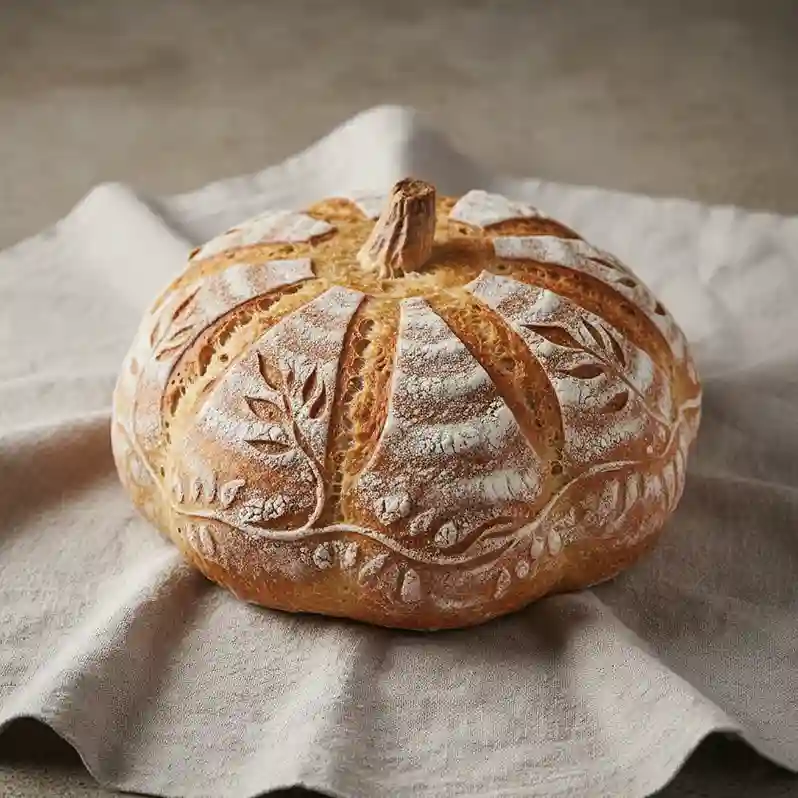There are recipes that quietly win your heart the moment they come out of the oven — this pumpkin sourdough bread is one of them.
The first time I made it, I wasn’t chasing perfection or shape; I simply wanted to bake bread that smelled like home.
The dough felt alive in my hands — soft, warm, and slightly sticky — and when it baked, the kitchen turned golden with the scent of pumpkin and toasted grain.
That loaf didn’t just rise; it bloomed like a piece of art. Each line I scored turned into a rustic pattern, and when I untied the string after baking, it looked like a real pumpkin sitting on my counter — round, golden, and full of character.
The crust cracked in all the right places, the crumb was light but tender, and every slice had that gentle sweetness only pumpkin can bring.
This bread isn’t rushed. It teaches you patience — from the quiet hours of fermentation to the final moment when you lift the lid and see that perfect shape.
It’s beautiful enough for a special table yet humble enough for a simple breakfast.
A loaf that feels both seasonal and timeless, made with care, warmth, and a little intention in every fold.
Pumpkin Sourdough Bread Recipe
Ingredients
- 100g active sourdough starter (bubbly and ripe)
- 350g water (room temperature)
- 100g pumpkin puree (homemade or canned, unsweetened)
- 500g bread flour
- 50g whole wheat flour
- 10g fine sea salt
- 1 tablespoon olive oil (optional, for a softer crust)
- Rice flour (for dusting)
- Twine or string (for shaping)
- A small cinnamon stick or breadstick (for pumpkin stem, optional)
Instructions
- A few hours before baking, feed your sourdough starter and let it rise until it becomes active, bubbly, and doubles in volume.
- In a large bowl, combine the active starter, water, and pumpkin puree. Stir well until blended. Add bread flour and whole wheat flour. Mix with a spatula or your hand until no dry bits remain. The dough will be shaggy and sticky. Cover the bowl and let it rest for 45 minutes (autolyse).
- Sprinkle salt and drizzle olive oil over the dough. Use your hands to pinch and fold the dough several times until the salt dissolves and everything is evenly mixed.
- Cover the bowl and let the dough rest at room temperature (ideally 24–26°C) for 4 to 5 hours. During this time, perform 3 sets of stretch-and-folds every 30 minutes in the first 1½ hours. After the last fold, let the dough rest undisturbed until it becomes slightly puffy and increases in volume by about 50%.
- Lightly flour your work surface. Turn the dough out gently and form it into a loose round ball. Cover and rest for 20 minutes.
- Shape the dough into a tight round ball by folding edges toward the center, creating surface tension. Place the shaped dough seam-side up in a well-floured banneton or bowl lined with a floured cloth. Cover and refrigerate overnight (8–12 hours) for cold fermentation. This step improves flavor and texture.
- The next day, preheat your oven to 250°C (480°F) with a Dutch oven inside. Cut 6–8 long pieces of kitchen twine and lightly coat them with oil to prevent sticking. Place the twine pieces on parchment paper like spokes of a wheel, with the center overlapping. Gently flip your chilled dough onto the middle of the twine setup (seam-side down). Tie each string loosely over the dough to form pumpkin-like sections — don’t tie too tight, as the dough will expand.
- Lightly dust the dough with rice flour. Use a sharp razor or lame to make delicate leaf and vine patterns between the sections. Scoring allows the bread to expand beautifully in the oven while keeping its decorative look.
- Carefully lift the dough (with parchment) and place it into the preheated Dutch oven. Cover and bake for 25 minutes. Then remove the lid, reduce the temperature to 220°C (430°F), and bake another 20–25 minutes until deep golden brown.
- Transfer the bread to a wire rack. Let it cool completely before removing the strings. Insert a small cinnamon stick or breadstick at the top center as a stem for a realistic pumpkin look.

How To Get The Perfect Pumpkin Shape In Pumpkin Sourdough Bread?
Getting that lovely pumpkin shape may look difficult, but it’s actually simple when done with care and patience. The key is to use kitchen twine and tie it properly before baking.
- Use Oiled Twine: Lightly coat the twine with oil before tying to stop it from sticking to the dough.
- Tie Loosely: Always tie the dough loosely because it will expand during proofing and baking.
- Divide Evenly: Arrange 6 to 8 strings evenly like spokes of a wheel for balanced pumpkin sections.
- Flip Seam Side Down: Place the dough seam-side down before tying, so the top remains smooth and beautiful.
- Add A Stem After Baking: Use a small cinnamon stick or breadstick at the center for a natural pumpkin look.
The shape becomes more defined when the dough has enough tension and is properly proofed. If it’s underproofed, the bread may burst unevenly; if overproofed, the ridges might fade.
How To Make Pumpkin Sourdough Bread Soft And Fluffy?
Pumpkin sourdough bread can be soft and airy if you balance the hydration and handle the dough gently.
- Use Ripe Starter: A strong, bubbly starter gives better rise and open crumb.
- Fold, Don’t Knead: Gentle stretch-and-fold movements strengthen gluten without overworking the dough.
- Add Pumpkin Puree Carefully: Too much puree makes the dough heavy. Stick to the amount mentioned in the recipe for the right texture.
- Cold Fermentation: Let the dough rest overnight in the fridge. Slow fermentation improves flavor and crumb softness.
- Cool Before Cutting: Cutting warm bread traps steam inside and can make the crumb gummy. Always wait until fully cooled.
How To Make Pumpkin Puree For Bread?
Fresh pumpkin puree adds natural color and flavor to sourdough bread. Here’s a simple method you can follow at home.
- Select The Right Pumpkin: Choose a small, sweet variety like sugar pumpkin or kabocha for a smooth puree.
- Roast Until Tender: Cut, deseed, and roast the pumpkin at 200°C until the flesh turns soft.
- Blend Until Smooth: Scoop out the flesh and blend into a creamy puree without adding water.
- Remove Extra Moisture: If the puree feels watery, strain it through a cloth to avoid making the dough sticky.
- Store Properly: Keep it refrigerated in an airtight container for up to 5 days or freeze for a month.
Why Is My Pumpkin Sourdough Bread Dense?
A dense loaf usually happens because of incorrect fermentation or weak starter activity.
- Underproofing: If the dough hasn’t risen enough, the gluten won’t expand during baking. Let it proof longer next time.
- Inactive Starter: Feed your starter regularly and ensure it doubles in size before use.
- Too Much Pumpkin: Extra puree adds moisture and weight, making the dough heavy.
- Cold Dough: Dough that’s too cold before baking doesn’t rise well. Let it come to room temperature.
- Low Oven Heat: Always preheat the oven properly; a hot oven helps the loaf spring and form a crisp crust.
How Long Should Pumpkin Sourdough Bread Ferment?
Fermentation time decides both flavor and texture. The right timing depends on room temperature and starter strength.
- Bulk Fermentation: At around 24–26°C, it usually takes 4 to 5 hours.
- Cold Fermentation: Overnight (8–12 hours) in the fridge gives the bread a deeper flavor and better structure.
- Visual Clues: The dough should look puffy, feel airy, and increase by about 50% in volume.
Always focus more on the dough’s behavior than on the clock, as each starter and environment can differ.
Can I Make Pumpkin Sourdough Bread Without A Dutch Oven?
Yes, you can still bake beautiful pumpkin sourdough bread without a Dutch oven by creating steam in your oven.
- Use A Baking Stone: Place your dough on a preheated baking stone or heavy tray for even heat.
- Add Steam: Put a tray with hot water or a few ice cubes at the bottom of the oven when you start baking.
- Cover Temporarily: If possible, cover the dough with an oven-safe metal bowl for the first 20 minutes, then remove it to brown the crust.
- Monitor Baking Time: Without a Dutch oven, bread might brown faster, so check a few minutes early.
What Type Of Flour Is Best For Pumpkin Sourdough Bread?
The flour choice decides the structure and flavor of your bread.
- Bread Flour: Provides strength and helps the loaf rise tall with open texture.
- Whole Wheat Flour: Adds deeper flavor and nutrition but use in smaller amounts to avoid heaviness.
- Unbleached Flour: Always choose unbleached for natural fermentation.
- High Protein Flour: More protein supports strong gluten formation, especially useful when adding pumpkin puree.
Can I Add Spices Or Seeds To Pumpkin Sourdough Bread?
You can easily personalize the flavor with mild spices or seeds that match pumpkin’s earthy taste.
- Cinnamon Or Nutmeg: A pinch adds warmth without overpowering.
- Pumpkin Seeds: Sprinkle inside or on top for crunch.
- Sunflower Or Sesame Seeds: These give nutty aroma and rustic look.
- Herbs: Small amounts of rosemary or thyme add gentle fragrance.
Always mix seeds after the first stretch-and-fold so they don’t tear the dough.
How To Store Pumpkin Sourdough Bread Properly?
Proper storage keeps the crust crisp and the crumb moist for days.
- Room Temperature: Wrap the cooled bread in a clean cotton cloth or store it in a bread box for up to 2 days.
- Freezing: Slice the loaf, wrap each portion tightly in plastic or a freezer bag, and freeze for up to 2 months.
- Reheating: Warm frozen slices in the oven or toaster until soft and fragrant again.
- Avoid Refrigeration: Fridge temperature dries the bread quickly and makes it tough.

How To Use Leftover Pumpkin Sourdough Bread?
Leftover bread never goes to waste if used creatively.
- French Toast: Dip slices in a spiced milk mixture and pan-fry for a rich breakfast.
- Croutons: Cut into cubes, drizzle with oil, and bake until crispy.
- Bread Pudding: Combine with milk, sugar, and eggs for a warm dessert.
- Stuffing: Cube and toss with herbs, butter, and stock for savory side dishes.
Each use adds a new life to your homemade loaf while keeping waste minimal.
How To Keep The Crust Crispy For Longer?
A crisp crust is one of the best parts of sourdough, and it can last longer with a few simple steps.
- Cool On A Wire Rack: This prevents moisture from collecting at the bottom.
- Avoid Plastic Wrap: Plastic traps moisture, making the crust soft.
- Reheat Before Serving: A few minutes in a hot oven refreshes the crust beautifully.
- Proper Ventilation: Once baked, leave it uncovered for at least an hour to let the steam escape.
Crisp crust depends on correct baking temperature and enough steam during the first half of baking.
You May Also Like To Check Out These Recipes
- Oven Roasted Sweet Potatoes Wedges
- Roasted Sweet Potato Black Bean Bowl
- Creamy Pumpkin Soup With Roasted Seeds
- Hatch Chile Chicken Enchiladas
- Hatch Chile Corn Chowder
- Hatch Chile Cream Cheese Dip
- Hatch Green Chile Queso Dip
- Creamy Pumpkin Soup With Roasted Seeds
- Mexican Street Corn Soup
- Pumpkin Chocolate Chip Bread
- Pumpkin Bread
- Pumpkin Bread Truffles
- Freezer-Friendly Chocolate Chip Zucchini Bread
- Jalapeño Cheddar Bread
- Cheeseburger Soup
- Chicken Broccoli Casserole
- Chicken Parmesan
- Buffalo Chicken Dip
- Chicken And Dumplings
- Crockpot Butter Chicken
- Creamy Cajun Chicken Pasta
- Chicken Tortilla Soup
- Sausage Potato Soup
- Sourdough Focaccia Bread

